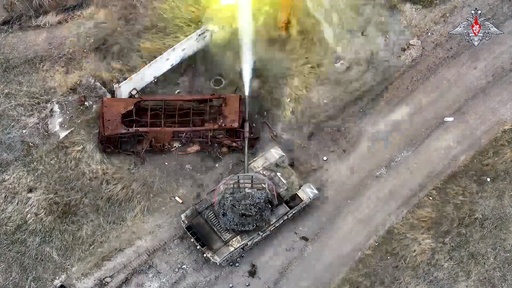KYIV, Ukraine (AP) — Russia and Ukraine are trading fresh accusations over renewed threats to Europe’s largest nuclear plant that has been caught up in the war, with Moscow alleging Ukraine was behind drone attacks on the facility that were witnessed by U.N. inspectors and Kyiv accusing Russia of disinformation tactics.
Kremlin spokesman Dmitry Peskov on Monday called the drone attacks on the Zaporizhzhia Nuclear Power Plant in Russian-occupied southern Ukraine “a very dangerous provocation.”
“This is a very dangerous practice that has very bad, negative consequences in the future,” Peskov said during his daily conference call with reporters.
The U.N.’s atomic watchdog agency on Sunday confirmed drone strikes on one of the plant’s six reactors, which caused one casualty, but did not attribute responsibility to either side.
The Associated Press was unable to verify either side’s claims in the area of heavy fighting where independent journalists are not allowed to enter.
An official at Energoatom, Ukraine’s atomic energy company, blamed Russia for the attacks, saying they were “a provocation” orchestrated to malign Ukraine.
The official spoke to The Associated Press on condition of anonymity because he was not authorized to speak on the record.
The plant has repeatedly been caught in the crossfire since Russia launched its full-scale invasion of Ukraine in February 2022 and seized the facility shortly after. The International Atomic Energy Agency, a U.N. body, has frequently expressed alarm about the plant amid fears of a potential nuclear catastrophe.
The strikes did not compromise the nuclear facility, which the Kremlin’s forces have been occupying and running in southern Ukraine since shortly after the war began more than two years ago, the IAEA said. The plant’s six reactors have been shut down for months, and IAEA inspectors are stationed at the site.
Propaganda and disinformation have been used as weapons by both sides during the conflict, and both sides have accused each other on other occasions of planning attacks on the plant.
Last July, Ukraine and Russia accused each other of planning to attack the Zaporizhzhia plant, though neither side provided evidence to support their claims.
Even with its reactors shut down, the plant still needs power and qualified staff to operate crucial cooling systems and other safety features.
The IAEA team did not observe structural damage to the “systems, structures and components” important to the nuclear safety of the plant, it said. They reported superficial scorching to the top of a reactor dome.
The damage “has not compromised nuclear safety, but this is a serious incident (with the) potential to undermine (the) integrity of the reactor’s containment system,” the IAEA said on X, formerly Twitter.
IAEA chief Rafael Mariano Grossi said the main reactor containment structures took at least three direct hits. “This cannot happen,” he said on X.
Zaporizhzhia is one of four regions that Russia illegally annexed in September 2022.
The Institute for the Study of War, a think tank based in Washington, said Russian authorities are seeking “to use Russia’s physical control over the (plant) to force international organizations, including the IAEA, to meet with Russian occupation officials to legitimize Russia’s occupation of the (plant) and by extension Russia’s occupation of sovereign Ukrainian land.”
___
Associated Press Writer Yuras Karmanau in Tallinn, Estonia, contributed to this report.
___
Follow AP’s coverage of the war in Ukraine at https://apnews.com/hub/russia-ukraine
Home World Live Russia Ukraine war Ukraine and Russia trade fresh accusations of targeting a major nuclear power...
